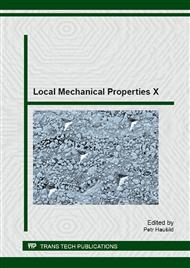p.117
p.121
p.125
p.129
p.133
p.137
p.141
p.145
p.151
Nanoindentation of Human Tooth Dentin
Abstract:
Biological tissues belong to the group of materials highly dependent on its micro structure. A variety of results may be found in the study of human teeth whose local composition and mechanical characteristics show considerable variations. The article deals with the measurement of elastic micromechanical characteristics in the root part of human tooth dentin. An extracted tooth was analyzed in two typical directions, i.e. longitudinal (from the tooth crown-neck to the root) and transverse (in the middle of the root part). Values of the modulus of elasticity in walls of the tooth root in the longitudinal and transverse directions were identified by means of nanoindentation. The development of the modulus of elasticity was measured in several parallel rows proceeding from the outer edge of the tooth root towards the root canal. The values measured in the dentin part of the tooth root ranged around ~17 GPa (cement-dentin boundary), ~23 GPa (middle part of dentin) and ~14 GPa (dentin-root part interface). In the longitudinal section, the value of the modulus of elasticity was almost constant in the majority of tested volume (~18 GPa) with some deviations in peripheral part (end of the root) due to changes in microstructural orientation from sagittal plane. The differences revealed a low degree of anisotropy of dentin.
Info:
Periodical:
Pages:
133-136
Citation:
Online since:
March 2014
Authors:
Keywords:
Price:
Сopyright:
© 2014 Trans Tech Publications Ltd. All Rights Reserved
Share:
Citation:


